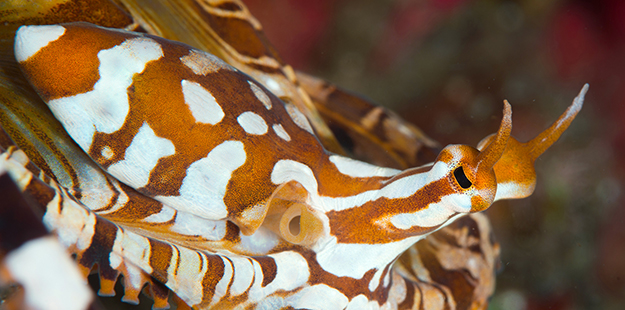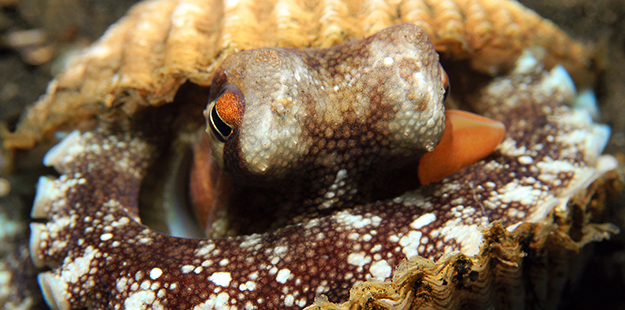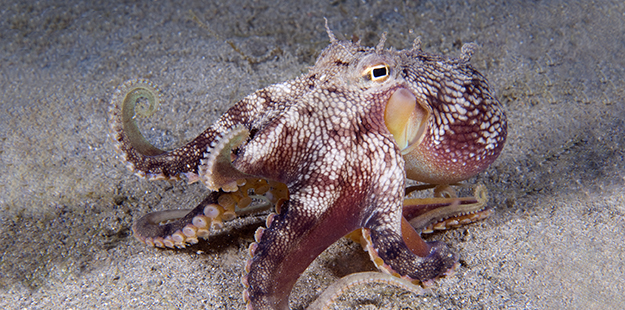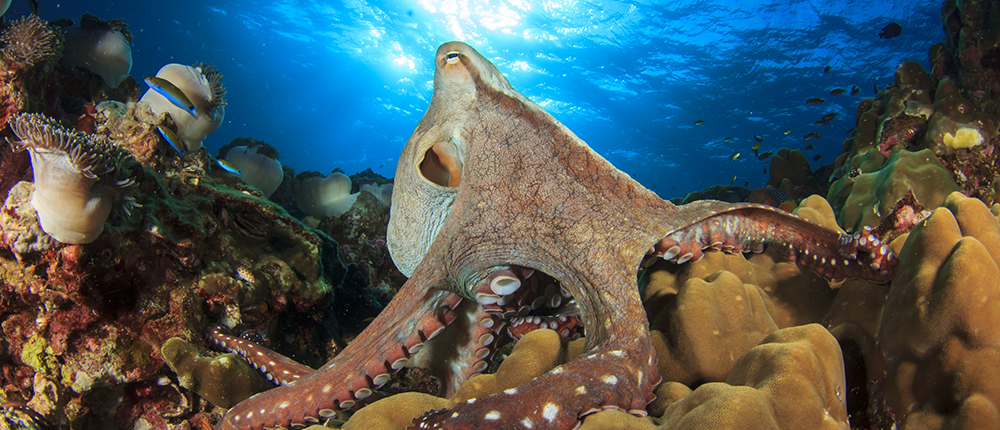Three Hearted Blue Bloods
Wakatobi’s resident octopus can put on quite a show for those who know where to look
Flailing tentacles capture unsuspecting prey with suction discs, then draw the victim towards a venomous beak. Three hearts pump blue blood through a shape-shifting body that seems to disappear by taking on the colors and patterns of its surroundings. The creature displays native cunning; it adapts and learns. No, it’s not an alien dreamed up by a science fiction writer. The creature is real, and you’ll find it lurking on the reefs of Wakatobi.
Octopus truly are among the ocean’s most intriguing animals. The reefs and shallows around Wakatobi are home to several dozen species of these stealthy cephalopods, and should you spot one, you are in for an entertaining treat. Some are masters of camouflage and misdirection, while others use a combination of natural cover and improvised props to cloak their movements. Let’s look at a few of the more notable and unique species, and some interesting facts about them.

Did you know these clever relatives of the snail and clam family have three hearts? Two of the hearts move blood beyond the octopus’s gills, while the third keeps circulation flowing for the organs. Photo by Wakatobi Dive Resort

Swimming over the reef you may spot a large octopus perched on or next to a coral head serenely watching the world go by. This is probably a big blue octopus, also referred to as Cyane’s or day octopus. Unlike its nocturnal relatives, this species is seen typically during the day. Photo by Rich Carey
Big, but not always blue
Look closely into the nooks and crannies of the reef and you might catch a glimpse of a big blue octopus sneaking about. Despite this common name–it’s also referred to as the day octopus or Cyane’s octopus–these animals are as likely to display colors from brown to purple as they are a namesake shade of blue. In addition, they may or may not sport mottled or spotted patterns on their mantle and tentacles, and these patterns shift constantly. Whatever coloration and skin pattern they display, you’ll know the big blue octopus by its size. These are the largest octopus living on Wakatobi’s reefs, growing to lengths of 80 centimeters. They are also the most active, as they are daylight feeders who rely on camouflage rather than darkness to cloak their movements.
Scientists have documented this species changing it’s appearance more than a thousand times over the course of a day.
Once you locate a big blue, it’s worth following along for a while to marvel at the rapidity and accuracy with which the octopus can change skin patterns and shape to match its surroundings. Scientists have documented this species changing it’s appearance more than a thousand times over the course of a day. This talent for morphing not only provides protection from would-be predators, but allows the big blue octopus to stalk its own prey undetected. This animal is known as an intelligent and aggressive hunter, using its muscular tentacles and strong suction disks to capture and hold victims, drawing them within reach of the sharp beak. Depending on the environment, you may see a big blue octopus slithering through reef cover, walking along the bottom, or swimming in open water. When startled, they can jet away with a quick burst of expelled water, and they may release a cloud of ink as a parting gift.

Not much larger than your hand (around 15 centimeters long), the sly little coconut octopus finds it is often easier to take their home with them when the need to relocate to new surroundings is called for. Photo by Wakatobi Dive Resort
Nut jobs
If you happen to spot what looks like the empty shell of a coconut bouncing or drifting along the reef, take a closer look. Inside that discarded husk you may find one of nature’s most ingenious scavengers. When moving about, the coconut octopus often relies on props for concealment. Mollusc shells may do the trick, but even better are the discarded remnants of a coconut. Hence the animal’s name. When this sly little cephalopod finds a discarded husk, it slips inside. Wearing the coconut as a helmet as it walks across the sea floor, extending tentacles act like legs as the octopus moves with a slight bouncing motion that mimics drifting debris. Even more comical are those times when the octopus clutches two halves of a discarded shell, placing itself inside and holding the pieces together to create what looks like an intact nut. Coconut husks are also used to build a defensive fortress around a favorite burrow or to create a hunting blind where it can hide in wait for a passing meal.

When threatened, the coconut octopus might flip the shell and comically scurry away like a cartoon character. Should they abandon their “home,” the typical walking stance of this little guy might remind you of a prize fighter holding two of its arms in a boxer’s stance. Photo by Walt Stearns
These are a relatively small octopus, growing to around 15 centimeters in overall length, with arms that are usually dark in color, with contrasting white suckers. Around Wakatobi, you are most likely to find them along the edges of the grass beds near the resort beach, or in other shallow areas near mangrove forests.


